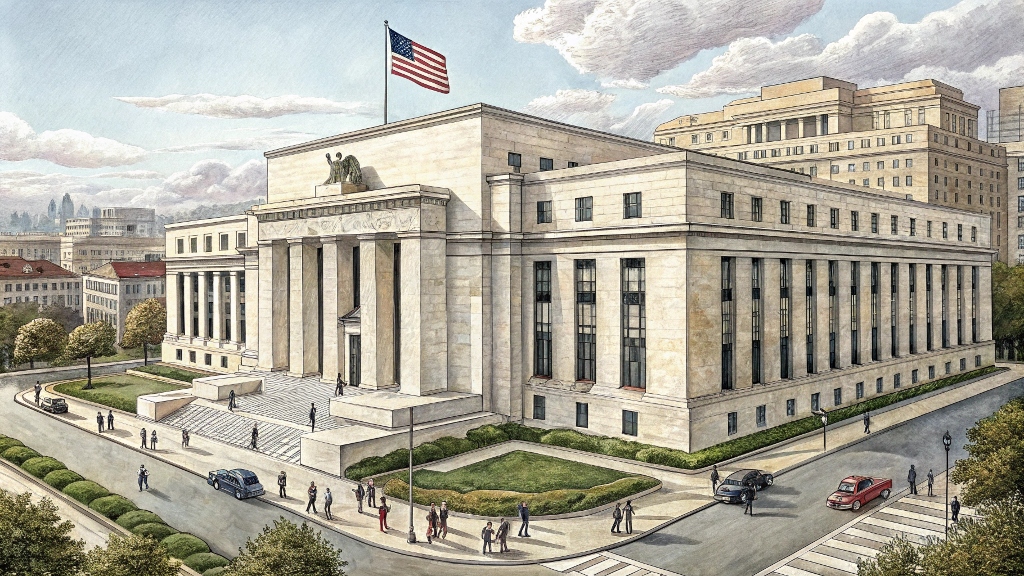
Powell’s Clarity on Crypto Independence Marks a Defining Moment for U.S. Monetary Policy
The Federal Reserve, under the leadership of Chairman Jerome Powell, has once again made its position on Bitcoin and other cryptocurrencies unmistakably clear: the U.S. central bank has no intention of acquiring or integrating Bitcoin into its monetary policy framework. This latest reiteration, delivered during recent congressional testimony and public statements, underscores the Fed’s unwavering commitment to traditional monetary tools and its cautious approach to the rapidly evolving world of digital assets.
For the cryptocurrency community, investors, and policymakers, the Fed’s stance is a significant marker of the boundaries between traditional finance and the burgeoning crypto sector. While Bitcoin and other digital currencies have captured the imagination of millions and reshaped global financial markets, the Federal Reserve’s position sends a strong signal about the limits of their influence within the established monetary system.
The Federal Reserve’s Official Stance on Bitcoin
The Federal Reserve’s approach to Bitcoin has been consistent and measured. Chairman Powell has repeatedly emphasized that Bitcoin is not considered a currency or a financial instrument suitable for inclusion in the Fed’s monetary policy toolkit. Instead, the central bank views Bitcoin as a speculative asset, distinct from the U.S. dollar and other fiat currencies under its purview.
This distinction is crucial. While the Federal Reserve actively manages the money supply, sets interest rates, and oversees the stability of the financial system through traditional means, it does not see a role for Bitcoin in these operations. The Fed’s balance sheet, a critical tool for implementing monetary policy, remains firmly rooted in government securities, mortgage-backed securities, and other conventional assets. Bitcoin, with its volatility and decentralized nature, does not fit into this framework.
Powell’s Recent Statements and the Context of Crypto Regulation
In recent months, as interest in cryptocurrencies has surged and regulatory discussions have intensified, Chairman Powell has taken opportunities to clarify the Fed’s position. During congressional hearings and public appearances, he has reiterated that the central bank has no plans to acquire or hold Bitcoin as part of its monetary operations. These statements are not merely technical clarifications; they are intended to provide certainty to markets and to reinforce the Fed’s focus on its core mandate of price stability and maximum employment.
Powell has also highlighted the importance of regulatory clarity and oversight in the cryptocurrency space. While the Fed does not directly regulate Bitcoin, it plays a key role in shaping the broader financial regulatory environment. Powell has called for clear rules to protect investors, maintain financial stability, and prevent illicit activities. However, he has been careful to distinguish between the need for sensible regulation and the idea that Bitcoin could ever replace the U.S. dollar or become a central tool of monetary policy.
The Broader Regulatory Landscape for Cryptocurrencies
The Federal Reserve’s stance on Bitcoin is part of a larger regulatory landscape in the United States. Cryptocurrencies are generally treated as assets rather than currencies, subject to oversight by agencies such as the Securities and Exchange Commission (SEC) and the Commodity Futures Trading Commission (CFTC). The Internal Revenue Service (IRS) also treats crypto as property for tax purposes, further reinforcing its status as an asset class.
This regulatory approach reflects both the opportunities and risks associated with digital assets. On one hand, the U.S. government recognizes the potential for innovation and financial inclusion that cryptocurrencies offer. On the other, it is acutely aware of the risks posed by volatility, fraud, and money laundering. The Fed’s position is thus aligned with a cautious, measured approach that seeks to balance innovation with stability.
What Powell’s Clarity Means for Crypto Investors
For cryptocurrency investors, Powell’s statements provide important context. The Fed’s explicit rejection of Bitcoin as a monetary policy tool means that, at least for the foreseeable future, the central bank will not be a buyer or seller of Bitcoin. This removes a potential source of demand or price volatility tied to official central bank actions, but it also means that Bitcoin’s value will continue to be determined by market forces rather than government intervention.
Investors should also take note of the broader regulatory environment. While the Fed’s stance is clear, other agencies are actively shaping the rules for crypto trading, custody, and taxation. Staying informed about these developments is essential for anyone involved in the crypto market.
The Role of the U.S. Dollar and the Fed’s Mandate
The U.S. dollar remains the world’s primary reserve currency, and the Federal Reserve’s mandate is to ensure its stability and reliability. This mandate is carried out through traditional tools such as open market operations, discount rate adjustments, and reserve requirements. Bitcoin, with its fixed supply and decentralized issuance, operates on fundamentally different principles.
Chairman Powell has made it clear that the Fed’s focus is on maintaining the integrity of the dollar and the broader financial system. While the central bank monitors developments in the crypto market, it does not see Bitcoin as a threat or a replacement for the dollar. Instead, the Fed views digital assets as a new and evolving part of the financial landscape—one that requires careful observation but not direct involvement.
The Impact of the Fed’s Stance on Global Central Banks
The Federal Reserve’s position on Bitcoin is closely watched by central banks around the world. Many countries are grappling with how to regulate and integrate digital assets into their financial systems. The Fed’s cautious, hands-off approach serves as a model for some, while others are exploring more active roles for central bank digital currencies (CBDCs) and other innovations.
In the European Union, the European Central Bank has also taken a measured approach to cryptocurrencies, emphasizing the need for regulation and consumer protection. In contrast, countries like El Salvador have embraced Bitcoin as legal tender, illustrating the diversity of approaches to digital assets globally. The Fed’s stance, however, remains a benchmark for stability and prudence in the face of rapid technological change.
The Future of Bitcoin and Monetary Policy
Looking ahead, it is unlikely that the Federal Reserve will change its position on Bitcoin in the near term. The central bank’s commitment to traditional monetary tools and its focus on stability are deeply ingrained. However, the rapid pace of innovation in the crypto sector means that the Fed will continue to monitor developments and adapt its regulatory approach as needed.
For Bitcoin and other cryptocurrencies, this means that their path forward will be shaped by market demand, technological advances, and regulatory developments—not by central bank intervention. Investors and market participants should expect continued volatility and uncertainty, but also the potential for significant growth as the crypto ecosystem matures.
The Intersection of Innovation and Regulation
The Federal Reserve’s stance on Bitcoin highlights the delicate balance between innovation and regulation in the financial sector. While the central bank recognizes the transformative potential of blockchain technology and digital assets, it is also mindful of the risks they pose to financial stability and consumer protection.
This balance is not unique to the United States. Around the world, policymakers are grappling with how to foster innovation while safeguarding the integrity of the financial system. The Fed’s approach—cautious, measured, and focused on its core mandate—serves as a reference point for these discussions.
The Crypto Community’s Response
Within the cryptocurrency community, the Federal Reserve’s position is met with a mix of understanding and frustration. Many crypto advocates appreciate the clarity and certainty that Powell’s statements provide, even if they disagree with the central bank’s cautious approach. Others argue that the Fed’s stance underestimates the potential of digital assets to transform finance and promote financial inclusion.
Regardless of these differing views, the Fed’s position is a reminder that the integration of cryptocurrencies into the mainstream financial system will be a gradual and complex process. For now, Bitcoin and other digital assets remain largely outside the realm of central bank monetary policy, operating in a space defined by market forces and regulatory oversight.
The Broader Implications for the Financial System
The Federal Reserve’s reaffirmation of its stance on Bitcoin has broader implications for the financial system. By clearly delineating the boundaries between traditional finance and digital assets, the central bank is helping to shape the future of money and payments. This clarity is essential for investors, businesses, and policymakers as they navigate an increasingly complex and interconnected global economy.
As the crypto sector continues to evolve, the Fed’s position will serve as a stabilizing force, providing a benchmark for prudence and responsibility. At the same time, the rapid pace of innovation in digital assets ensures that the conversation about their role in the financial system is far from over.
What’s Next for Crypto and Central Banking
The relationship between cryptocurrencies and central banks is likely to remain a topic of intense debate and scrutiny. While the Federal Reserve has made its position clear, other central banks may take different approaches as they explore the potential of digital currencies and blockchain technology.
For now, the Fed’s focus remains on its traditional mandate: ensuring the stability and reliability of the U.S. dollar and the broader financial system. Bitcoin and other cryptocurrencies, while influential and innovative, are not part of that mandate. As the financial landscape continues to evolve, the Fed’s clarity and consistency will be critical in guiding the future of both traditional and digital finance.

















